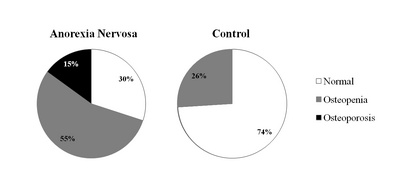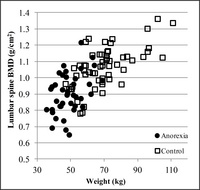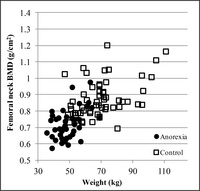10. tbl. 98. árg. 2012
Bone mineral density of young women with history of anorexia nervosa
AN and identify predictors which might be targets for preventive measures.
Material and methods: The study was retrospective. Participants were women aged 18-40 years, with diagnosis of AN (F50.0, F50.1) attending the anorexia unit at Landspítali – The National University Hospital of Iceland - in 2001-2009, who had undergone measurement of BMD by dual-energy X-ray absorptiometry. A control group consisted of 58 healthy 30 years old women participating in a study of bone health in 2001-2003.
Results: At time of BMD measurement the median body mass index (BMI: kg/m2) in the AN group (n=40) was 17.4 (12.3-25.2) compared to 23.6 (18.1-43.7) in the control group (p<0,001). Lumbar spine and hip BMD were 15.3-17.5% lower in AN patients than in control subjects (p<0.001). In both groups there was a strong correlation between BMD and body weight (r=0.354-0.604, p<0.05) and lean mass (r=0.425-0.588, p<0.05). Among patients with AN a correlation was also seen between BMD and lowest weight during the illness (r=0.482-0.499, p<0.01). Among the 26 AN patients who had repeated BMD measurement, a significant decrease in BMD at femoral neck (-6.6%, p=0.030) was observed in those who lost weight between the measurements (n=9). Those who had BMI ≤17.5 between BMD measurements lost 5.5-7.1% of the BMD at the hip (p<0.05).
Conclusion: Young women with AN have 15% lower bone mass than healthy young women. The relationship between BMD and body weight seems to be a continuum across disease states. Increased body weight may be the most important factor for recovery of bone mass in AN patients.
Table I. Baseline characteristics of eating disorder patients with current or previous history of anorexia nervosa and the control group.
|
Anorexia Nervosa (n=40) |
Control (n=58) |
p-value | |
| Age (years) | 21.5 (18.2-36.5) | 30 (29-30) | <0.001 |
| Weight(kg) | 47 (36-69) | 69 (47-111) | <0.001 |
| Height (cm) | 166 ± 7 | 167 ± 6 | 0.521 |
| BMI (kg/m2) | 17.4 (12.3-25.2) | 23.6 (18.1-43.7) | <0.001 |
| CLO or vitamin use (%) | 66 a | 40 | 0.012 |
| Calcium supplements (%) | 49 b | 10 | <0.001 |
| Physical exercise (≥3/week) (%) | 33 c | 40 | 0.538 |
| Smoker or ex-smoker (%) | 59 d | 40 | 0.062 |
| History of fractures (%) | 40 a | 22 | 0.072 |
| Regular menses (%) | 23 | 85 | <0.001 |
| Age at menarche (ár) | 13 (10-18) e | 13 (11-17) | 0.46 |
| Use of BCP (%) | 20 | - | - |
Data are presented as mean ± SD for normal distribution, median (range) if non-normal distribution. BMI: body mass index, CLO: cod liver oil, BCP: birth control pills, a n=38, b n=37, c n=36, d n=39, e n=27.
Table II. Bone mineral density and body composition of patients with anorexia nervosa and the control group.
|
Anorexia Nervosa (n=40) |
Control (n=58) |
Difference (%) |
|
|
Lumbar spine BMD (g/cm2) T-score |
0.903 ± 0.125 -1.3 ± 1.2 |
1.066 ± 0.124 0.0 ± 1.0 |
15.3* |
|
Femoral neck BMD (g/cm2) T-score |
0.721 ± 0.091 -1.1 ± 0.8 |
0.874 ± 0.113 0.0 ± 1.0 |
17.5* |
|
Total hip BMD (g/cm2) T-score |
0.805 ± 0.101 -1.1 ± 0.8 |
0.967 ± 0.111 0.0 ± 1.0 |
16.8* |
| Total body BMD (g/cm2) | 1.065 ± 0.084 a | 1.135 ± 0.082 | 6.2* |
| Fat mass (kg) | 11.22 ± 4.91 a | 23.61 ± 10.06 | 52.5* |
| Lean body mass (kg) | 36.87 ± 5.01 a | 45.63 ± 5.70 | 19.2* |
Data are presented as mean ± SD. BMD: bone mineral density, *p<0.001, an=33.

Figure 1.Frequency of osteoporosis (T-score ≤-2,5) and osteopenia (T-score <-1,0 and >-2,5) in patients with anorexia nervosa and the control group.


Figure 2. Bone mineral density in lumbar spine (A) and the femoral neck (B) in relation to body weight.
Table III. Correlation between bone mineral density and clinical characteristics in patients with anorexia nervosa and the control group.
| Anorexia Nervosa (n=40) | Control (n=58) | |||||||
| Lumbar spine BMD | Femoral neck BMD | Total hip BMD | Total hip BMD | Lumbar spine BMD | Femoral neck BMD | Total hip BMD | Total hip BMD | |
| Weight at BMD measurement | 0.410** | 0.455** | 0.368* | 0.319 | 0.604** | 0.440** | 0.354** | 0.390** |
| Height at BMD measurement | 0.336* | 0.434** | 0.424** | 0.350* | 0.048 | 0.085 | 0.177 | 0.177 |
| BMI at BMD measurement | 0.274 | 0.260 | 0.164 | 0.189 | 0.573** | 0.342** | 0.255 | 0.273* |
| Lowest weight during illness | 0.499** | 0.482** | 0.490** | 0.497** | - | - | - | - |
| Highest weight | 0.308b | 0.290b | 0.133b | 0.338 | - | - | - | - |
| Fat mass | 0.259 | 0.190 | 0.211 | 0.067 | 0.178 | 0.071 | 0.070 | -0.088 |
| Lean body mass | 0.463** | 0.560** | 0.433* | 0.443 | 0.588** | 0.425** | 0.455** | 0.493** |
Correlation coefficient (r). BMD: bone mineral density, *p<0.05, **p<0.01, a n=33, b n=39.
Table IV. Changes in bone mineral density of women with anorexia nervosa, categorized by BMI under 17,5kg/m2or BMI over 17,5 between measurements.
|
Changes between BMD measurements |
BMI >17.5 kg/m2 between BMD measurements (n=9) | Change (%) | BMI ≤17.5 kg/m2 between BMD measurements (n=17) | Change (%) |
| Lumbar spine BMD (g/cm2) | 0.059 ± 0.109 | 7.6 ± 15.3 | -0.011 ± 0.058 | -1.0 ± 6.8 |
| Femoral neck BMD (g/cm2) | 0.024 ± 0.075 | 3.7 ± 11.6 | -0.053 ± 0.060 | -7.1 ± 7.9** |
| Total hip BMD (g/cm2) | 0.033 ± 0.090 | 4.3 ± 11.7 | -0.043 ± 0.061 | -5.5 ± 8.0* |
| Total body BMD (g/cm2) | 0.028 ± 0.040 a | 2.7 ± 4.1 | -0.012 ± 0.068 b | -0.9 ± 6.6 |
| Weight at BMD measurement (kg) | 6 ± 12 | 14.8 ± 29.3 | 1 ± 3 | 2.2 ± 7.2 |
Data are presentd as mean ± SD. BMD: bone mineral density, *p<0.05, **p<0.01, an=6, b n=12.
